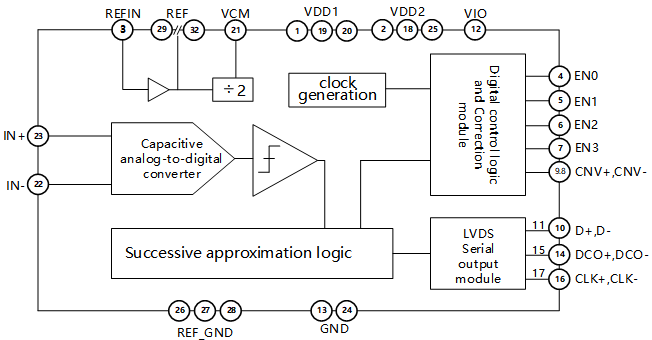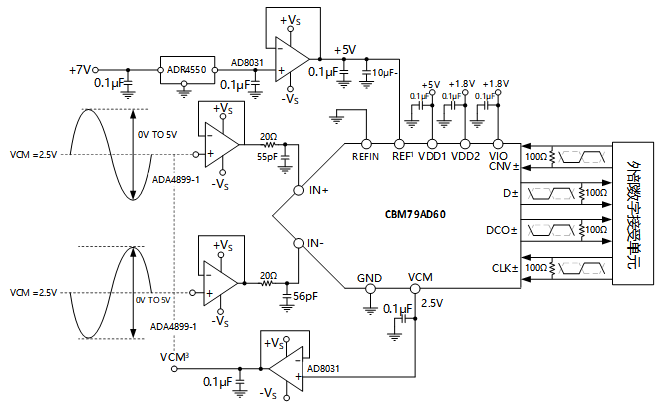 Released:2019-09-17 00:00:36
Released:2019-09-17 00:00:36 Views 1497 次
Views 1497 次 Corebai Microelectronics was founded in 2008, serving clients in the defense technology department and research institute. In 2014, Xinbai Microelectronics Beijing Company was officially established, and in 2017, ADC/DAC products were officially released to the public. After 10 years of technical accumulation by hundreds of engineers, the company has now mass-produced and provided ADC products for customers to use. Our company's products take high-speed and high-precision products as the entry point, launching a full range of ADCs covering SAR, Pipeline, and Sigma Delta architectures, ranging from 8BIT, 12BIT, 14BIT, 16BIT, and 18BIT, with sampling rates ranging from 40MSps to 1.5GSps
Corebai Microelectronics was founded in 2008, serving clients in the defense technology department and research institute. In 2014, Xinbai Microelectronics Beijing Company was officially established, and in 2017, ADC/DAC products were officially released to the public. After 10 years of technical accumulation by hundreds of engineers, the company has now mass-produced and provided ADC products for customers to use. Our company's products take high-speed and high-precision products as the entry point, launching a full range of ADCs covering SAR, Pipeline, and Sigma Delta architectures, ranging from 8BIT, 12BIT, 14BIT, 16BIT, and 18BIT, with sampling rates ranging from 40MSps to 1.5GSps

Corebai Microelectronics traces its origins back to its founding in 2008, initially serving clients within the defense technology sector and research institutes. In 2014, the company formally established Corebai Microelectronics (Beijing) Co., Ltd. Following three years of development, it officially launched its ADC/DAC product line in 2017, a testament to the decade-long technological accumulation by a team of over a hundred engineers.
Today, the company has successfully brought these ADC products into mass production and made them available to customers. In 2019, Corebai debuted its brand in the wider market, presenting a diverse product range spanning six major categories and comprising more than 300 individual models. Key offerings include ADC/DACs, USB interfaces, interface circuits, standard operational amplifiers, high-voltage op-amps, and instrumentation amplifiers.

The company's product portfolio takes as its entry point high-speed, high-precision offerings, introducing a comprehensive series of ADCs ranging from 8BIT to 18BIT resolution, with sampling rates spanning from 40MSps up to 1.5GSps. This lineup encompasses all major architectures, including SAR, Pipeline, and
Sigma-Delta, providing a full spectrum of options for various performance requirements.

Functional Block Diagram as shown above.
Corebai (Corebai) has recently launched the CBM79AD60, an 18-bit Successive Approximation Register (SAR) Analog-to-Digital Converter (ADC), featuring a sampling rate of 5 Mega Samples per Second (MSPS), which is twice that of all existing SAR-type converters. With its high precision, high sampling rate, and superior linearity, the CBM79AD60 SAR ADC is designed for low-power signal chains, multiplexing systems (such as digital X-ray), and oversampling applications, including spectrometers, MRI gradient control, and gas chromatographic analysis.
This type of A/D converter is an 18-bit, 5MSPS Successive Approximation Register (SAR) Analog-to-Digital Converter, comprising a low-power, high-speed 18-bit ADC core, internal conversion clock generation circuitry, error correction circuits, and a universal serial interface. Upon the rising edge of the conversion control signal (CNV), the device samples the voltage difference between the input ports IN+ and IN-, with the input specified as an inverted voltage signal ranging from 0V to VREF across these two ports. All conversion results are outputted via a serial High-Speed Low-Voltage Differential Signaling (LVDS) interface. The A/D converter is packaged in a 32-pin QFN32 package, with a recommended operating temperature range of -40°C to +85°C.

Suggested reference circuit of Corebai
Unlike other 18-bit analog-to-digital converters that achieve higher sampling rates at the expense of increased power consumption and reduced precision, the CBM79AD60 operates at a 5MSPS sampling rate while maintaining a power dissipation of only 64.5mW. Specifically optimized for exceptional DC linearity (±1.5LSB INL) and AC performance (95.5dB SNR), it consistently delivers these attributes even at full throughput. Its compact package size and low power footprint address space and thermal constraints faced by engineers designing high-density data acquisition systems.
Product Applications:
Digital Imaging Systems
Digital X-ray Machines
Medical Digital Tomography Infrared Cameras
Magnetic Resonance Imaging (MRI) Examinations
Gradient-Controlled High-Precision Data Acquisition Spectral Analysis
010-62106066
( Monday to Friday 9:00 - 18:00 )
 704-705, Block D, Building 2, No. 9 Fenghao East Road, Haidian District, Beijing
704-705, Block D, Building 2, No. 9 Fenghao East Road, Haidian District, Beijing

Wechat Public Account